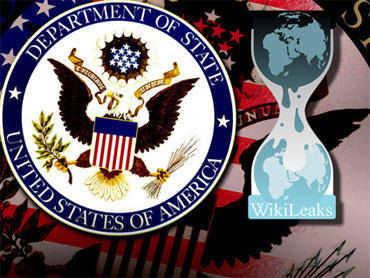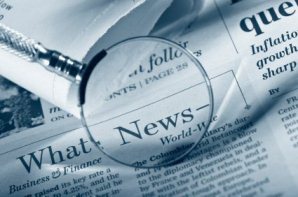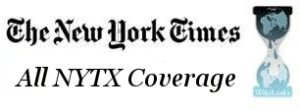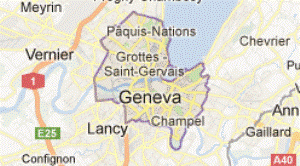PRESS THE PRESS » STRUCTURAL ANALYSIS » WIKILEAKS » WL FEATURED
The Fourth Estate Forfeiting Its Own Press Freedoms: WikiLeaks & The New York Times
February 8, 2012 · 0 Comments

By Chris Spannos:
While the world waits for Britain’s Supreme Court ruling on Julian Assange’s appeal against Sweden’s attempt to extradite the WikiLeaks’ editor, U.S. military prosecutors have ordered a court-martial for Private Bradley Manning who, in a tragic case, is accused of leaking the largest cache of classified information in U.S. history—more than 700,000 documents including a military video—and giving them to WikiLeaks. Manning faces 22 charges, including aiding the enemy, and could be imprisoned for life if found guilty of the latter charge.
As these two different but historic courtroom dramas unfold one of today’s greatest challenges to freedom of the press is quietly evolving in the background. This particular challenge does not come from the expected intrusion of state power into the realm of civil society. Instead, it comes from the willingness of mainstream media outlets such as the New York Times to opportunistically forfeit their own freedom of the press, along with everyone else’s first amendment rights, to protect their own interests. This challenge to freedom of the press is the motivation for NYT eXaminer’s (NYTX) January 10, 2012 Freedom of Information Act (FOIA) request addressed to the State Department for all communication between the department and The New York Times regarding WikiLeaks, Julian Assange, and Bradley Manning.
Press freedoms have experienced many old and new challenges but never before on such a scale as presented by WikiLeaks and the wilful submission of these freedoms by The Times. The notion that the mainstream media is an instrument to protect civil liberties against abuse of political power is central to our national ethos and which the U.S. constitution enshrines among its protections. For example, in its landmark 1971 ruling on the publication of the “Pentagon Papers” the Supreme Court decided in The New York Times Co. v. United States that:
In the First Amendment, the Founding Fathers gave the free press the protection it must have to fulfil its essential role in our democracy. The press was to serve the governed, not the governors. The Government's power to censor the press was abolished so that the press would remain forever free to censure the Government. The press was protected so that it could bare the secrets of government and inform the people. Only a free and unrestrained press can effectively expose deception in government. And paramount among the responsibilities of a free press is the duty to prevent any part of the government from deceiving the people and sending them off to distant lands to die of foreign fevers and foreign shot and shell.
In its treatment of WikiLeaks The Times has thoroughly undermined press freedoms that the Supreme Court upheld on its behalf. In its publication of Cablegate documents, The Times did not participate in the international consortium of media partners—organized by WikiLeaks—and instead acquired the cables through the Guardian (in violation of its contract with WikiLeaks). The Times then gave “the White House an early warning” of the cables it was going to publish and listened to Washington’s concerns relating to the cables. The Times shared these concerns with other news media outlets.
In his January 2011 New York Times Magazine article “Dealing With Assange and the WikiLeaks Secrets,” Bill Keller, then Executive Editor of The Times, justifies seeking clearance from the White House by arguing that “because of the range of the material and the very nature of diplomacy, the embassy cables were bound to be more explosive than the [Afghan/Iraq] War Logs.” To whom were the cables “bound to be more explosive?” It is implicit in Keller’s preoccupation with the “very nature of diplomacy” that his concerns lay with the way in which the U.S. Government (and its representatives in various consulates) would receive the cables. And yet, the press were granted constitutional protection to “serve the governed, not the governors,” so that it could, for example, “bare the secrets of government and inform the people.” For Keller, however, ensuring the continuance of current diplomatic relationships between the U.S. and other states was of primal concern—primal even to highlighting widespread corruption, human rights abuses, or war crimes in those other states.
Keller writes that The Times’ Washington bureau chief Dean Baquet gave the White House early warning on Nov. 19, 2010 and that on the following Tuesday Baquet and two others from The Times “were invited to a windowless room at the State Department, where they encountered an unsmiling crowd.” Keller tells us that this crowd was comprised of representatives from the White House, the State Department, the Office of the Director of National Intelligence, the C.I.A., the Defense Intelligence Agency, the F.B.I. and the Pentagon. “Others, who never identified themselves, lined the walls. A solitary note-taker tapped away on a computer.”
Keller wrote that this first meeting was off the record. However he explains that,
Subsequent meetings, which soon gave way to daily conference calls, were more businesslike. Before each discussion, our Washington bureau sent over a batch of specific cables that we intended to use in the coming days. They were circulated to regional specialists, who funnelled their reactions to a small group at State, who came to our daily conversations with a list of priorities and arguments to back them up. We relayed the government’s concerns, and our own decisions regarding them, to the other news outlets.
Keller reports that the administration’s concerns fell into three categories. The first category related to what Keller described as “the importance of protecting individuals who had spoken candidly to American diplomats in oppressive countries.” Keller says that The Times “always agreed” on which cables posed this threat and was “grateful to the government” for pointing out others. A major argument against WikiLeaks is that they did not adequately protect individuals at risk of reprisals following the publication of cables exposing their identity. However, in its press conference concerning the Iraq War Logs in London, WikiLeaks took pains to highlight their extensive redaction process. The process started with the assumption that every word in every document was sensitive and then sought to uncover those deemed unequivocally safe. The remainder were subject to legal and other advice. Keller’s depiction of The Times and the U.S. Government as taking the sensible approach to ensuring the protection of individuals seeks to undermine the work that WikiLeaks did to try and ensure the protection of individuals.
According to Keller, Washington expressed a second category of concerns with the cables originally published by WikiLeaks. This concern was that the cables published information relating to “sensitive American programs, usually related to intelligence.” Keller writes that “We agreed to withhold some of this information…” but that in other cases, “we went away convinced that publication would cause some embarrassment but no real harm.” However, The Times has a history of giving deference to U.S. Government “concerns.” In 2010, The Times participated in a media consortium (organized by WikiLeaks) to publish the War Logs. Many participants in the media consortium, including the leading German paper Der Spiegel and the British Guardian, each reported on Task Force 373—an elite unite of soldiers that includes members of the Navy Seals and Delta Force and who take orders directly from the Pentagon while operating outside the chain of command of NATO's International Security Assistance Force (ISAF). Julian Assange told NYT eXaminer that participants in the media consortium, including The Times, had—for maximum impact—coordinated their Task Force 373 stories for simultaneous release, “The story was written for the New York Times by Eric Schmitt, their senior national security reporter. The copy was filed but it was killed off editorially. It did not appear in any manner whatsoever at this simultaneous release.” As a participant in the media consortium organized by WikiLeaks, The Times was aware that the story would receive international readership. However, being the only paper with a widespread North American audience, such a decision suggests that The Times was showing deference to the concerns of the U.S. Government rather than concerning itself with serving the public with information and fulfilling its essential role in our democracy. It is also questionable whether The Times sought to warn other members of the media consortium against publishing articles on Task Force 373. If it did, then this would suggest that The Times is not only willing to relinquish its own press freedoms, but those of others too.
However, a similar issue was raised in the 1971 Pentagon Papers case. Here, the U.S. argued that the Pentagon Papers constituted; “the most sensitive and destructive” materials and, would do “substantial damage to public interests.” Although Justice Byron White agreed and was “confident that their disclosure will have that result,” he also gave primacy to protecting the freedom of the press and said that a very high bar had to be met in order to substantiate concerns that the release of materials would post substantial damage to public interests. Applying historical hindsight to the test of time, then Counsel to The Times in the Pentagon Papers case, James C. Goodale recently commented on Justice Byron White’s speculation about the dangerous effects of the Pentagon Papers:
It is now 40 years later, and no one has offered any proof that publication of anything in the Pentagon Papers damaged national security. Claims of damage to national security are routinely made when classified information is leaked and published. Yet, to the best of my knowledge, no such claims have ever been substantiated.
The administration was, thirdly and according to Keller, concerned with “cables that disclosed candid comments by and about foreign officials, including heads of state.” Keller writes that “The State Department feared publication would strain relations with those countries.” The Times, Keller says, was “mostly unconvinced.” But what is important to note is that Keller’s response conveys The Times with an undeserved “objective” cover. The Times would like to project itself as making smart decisions concerning those issues that it agrees with the administration about. Simultaneously, The Times also aims to portray itself as taking an independent stance where it disagrees. Keller tries to bolster his argument by giving an example of the “tension between a newspaper’s obligation to inform and the government’s responsibility to protect...” Keller explains that, following the attacks of Sept.11, 2001, the Bush administration tried to pressure The Times to withhold a story about the National Security Agency’s eavesdropping tactics. According to Keller, Bush argued that “if we published it, we should share the blame for the next terrorist attack.” “We were unconvinced by his argument and published the story,” he says. However, surely The Times can make most of these decisions without such embedded consultation with the U.S. Government. That The Times disagrees with the government on some of its positions does not negate the deference it shows to power by subjugating its own ability to make important journalistic assessments in cases that are ostensibly in the public’s interest.
In his example, Keller advances an idealistic idea of The Times as a liberal and objective institution protecting the public interest against state intrusion. However, Keller and The Times surely knew that the Bush administration eavesdropping story was one that The Times’ editorial decision-makers could credibly publish after weighing the risk. Bush administration backlash towards The Times would not have that great an impact on Times power or profits while, perhaps instead, it would further damage public perception of the Bush administration and, as a consequence, enhance The Times’ image. In contrast, the War Logs and Cablegate were much deeper and wider waters with systemic consequences impacting upon international order-giving and order-taking relations directed from the centers of American power and facilitated by its conduits—the U.S. embassies. Collaborating with WikiLeaks may at first make The Times look good by reinforcing the myth of a responsible Fourth Estate institution. However, we learn that throughout this period, The Times only published “safe” materials that would not harm the interests of its corporate advertisers and political power-brokers.
When NYT eXaminer asked Julian Assange what he thought about The Times consultation with the State Department, Assange replied:
In general I think that is absolutely outrageous and despicable journalistic practice. Which is not to say that it shouldn’t be done in some ways in some cases. But, why inform the perpetrator of an immoral act, that you are about to publish a story about them, before telling the victim? We’re talking here about perpetrators that are very powerful, have an extremely large media budget, and as soon as they are notified of an upcoming story attempt to spin the story.
We do not know the precise reasoning and details of the discussions that Keller had in his various—and often daily—meetings with the White House, they are yet to be known by anyone outside The Times or the U.S. State Department. But NYTX believes that these details will help the public better understand the process of how and why one of the largest and most powerful media institutions is willing to relinquish many of its own press freedoms and free speech and with corresponding effects on others. A better understanding of this process can help civil society more effectively advocate for new editorial standards in mainstream media—mainly to ask the powerful media to report the truth—and advance social action for civil rights and institutional change over state power.
Chris Spannos is Editor of NYT eXaminer.
Extra information:
Julian Assange is an NYT eXaminer Advisory Council member.
See NYT eXaminer’s ten part video interview with Assange about the New York Times.
See more about our Freedom of Information Act Request to the State Department asking for information regarding the meetings between the administration and the New York Times relating to WikiLeaks, Julian Assange, and Bradley Manning.
By cspannos










Sorry, comments are closed on this post.